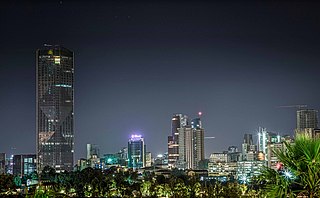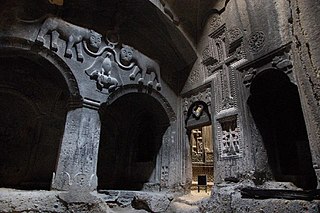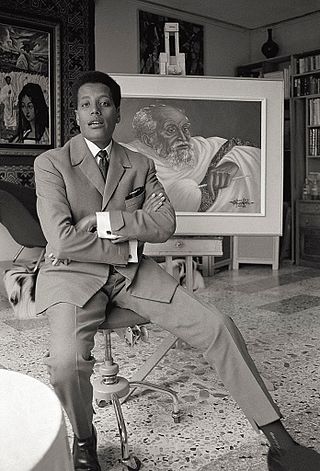
Addis Ababa is the capital and largest city of Ethiopia. In the 2007 census, the city's population was estimated to be 2,739,551 inhabitants. Addis Ababa is a highly developed and important cultural, artistic, financial and administrative centre of Ethiopia.

A monolithic church or rock-hewn church is a church made from a single block of stone. Because freestanding rocks of sufficient size are rare, such edifices are usually hewn into the ground or into the side of a hill or mountain. They can be of comparable architectural complexity to constructed buildings.

Lalibela is a town in the Amhara Region of Ethiopia. Located in the Lasta district and North Wollo Zone, it is a tourist site for its famous rock-cut monolithic churches designed in contrast to the earlier monolithic churches in Ethiopia. The whole of Lalibela is a large and important site for the antiquity, medieval, and post-medieval civilization of Ethiopia. To Christians, Lalibela is one of Ethiopia's holiest cities, and a center of pilgrimage.

The Amazing Race 6 is the sixth season of the American reality competition show The Amazing Race. Hosted by Phil Keoghan, it featured eleven teams of two, each with a pre-existing relationship, competing in a race around the world to win US$1,000,000. This season visited four continents and ten countries and traveled over 40,000 miles (64,000 km) during twelve legs. Starting in Chicago, racers traveled through Iceland, Norway, Sweden, Senegal, Germany, Hungary, France, Ethiopia, Sri Lanka, and Hawaii before finishing in Chicago. New twists introduced in this season include uniting teams for a task, the double-length leg, and limits on team members' Roadblock performances. The season premiered on CBS on November 16, 2004, and concluded on February 8, 2005.

Prince Makonnen Haile Selassie, Duke of Harar was the second son, and second-youngest child, of Emperor Haile Selassie of Ethiopia and Empress Menen Asfaw. He was made Mesfin of Harar upon the coronation of his parents in 1930.

Tabot is a replica of the Ark of the Covenant, and represents the presence of God, in Ethiopian Orthodox and Eritrean Orthodox Churches. Tabot may variously refer to an inscribed altar tablet, the chest in which this tablet is stored, or to the tablet and chest together.

The Zagwe dynasty was a medieval Agaw monarchy that ruled the northern parts of Ethiopia and Eritrea. The Agaw are a Cushitic ethnic group native to the northern highlands of Ethiopia and neighboring Eritrea. Centered at Roha, it ruled large parts of the territory from approximately 1137 to 1270 AD, when the last Zagwe King Za-Ilmaknun was killed in battle by the forces of the Amhara King Yekuno Amlak. The Zagwe are most famous for their king Gebre Mesqel Lalibela, who is credited with having constructed the rock-hewn monolithic churches of Lalibela.

Kaleb, also known as Saint Elesbaan, was King of Aksum, which was situated in modern-day Ethiopia and Eritrea

Afewerk Tekle was an Ethiopian artist, particularly known for his paintings on African and Christian themes as well as his stained glass.

Lalibela, regnal name Gebre Meskel, was a king of the Zagwe dynasty, reigning from 1181 to 1221. He was the son of Jan Seyum and the brother of Kedus Harbe. Perhaps the best-known Zagwe monarch, he is credited as the patron of the namesake monolithic rock-hewn churches of Lalibela. He is venerated as a saint by the Ethiopian Orthodox Tewahedo Church on 19 June.

The architecture of Ethiopia varies greatly from region to region. Over the years, it has incorporated various architectural styles and techniques.

In Search of King Solomon's Mines is a travel book by Anglo-Afghan author, Tahir Shah, relating his travels in Ethiopia with only local people for company and assistance.

Ethiopia is one of the oldest countries in Africa; the emergence of Ethiopian civilization dates back thousands of years. Abyssinia or rather "Ze Etiyopia" was ruled by the Semitic Abyssinians (Habesha) composed mainly of the Amhara, Tigrayans and the Cushitic Agaw. In the Eastern escarpment of the Ethiopian highlands and more so the lowlands was the home of the Harari/Harla that founded Sultanates such as Ifat and Adal and the Afars. In the central and south were found the ancient Sidama and Semitic Gurage, among others.
The Baháʼí Faith in Ethiopia began after ʻAbdu'l-Bahá wrote letters encouraging taking the religion to Africa in 1916. Probably the first Baháʼí to settle in the country came in early 1934 and with further pioneers by mid-1934, the first Baháʼí Local Spiritual Assembly of the country was elected in November in Addis Ababa. In 1962, Ethiopia Baháʼís had elected a National Spiritual Assembly. By 1963 there were seven localities with smaller groups of Baháʼís in the country. The Association of Religion Data Archives estimated some 27000 Baháʼís in 2005. The community celebrated its diamond jubilee in January 2009.

Ethiopian crosses, Abyssinian crosses, or Ethiopian-Eritrean crosses are a grouping of Christian cross variants that are symbols of Christianity in Ethiopia, Eritrea, and among Ethiopians and Eritreans. Their elaborate, stylized design is markedly distinct from other Christian cross variants. Ethiopian crosses are almost always made from elaborate latticework, the intertwined lattice represents everlasting life. No two crosses are exactly identical in style, the artisans who make them being allowed the freedom to exercise a measure of individual taste and creativity in their choice of shape and pattern. Crosses may be of the processional type with a socket at the base so they may be mounted on a staff and carried in church ceremonies or hand-held blessing crosses used by priests in benedictions.

Ethiopian art is the manifestation in art of the Ethiopian civilization, an African Christian civilization that developed for millennia in relative isolation . The main artistic expressions have been architecture, painting and goldsmithing. There is also a range of traditions in textiles, many with woven geometric decoration, although many types are also usually plain.

The Arbegnoch were Ethiopian anti-fascist World War II resistance fighters in Italian East Africa from 1936 until 1941 who fought against Fascist Italy's occupation of the Ethiopian Empire.
The Washa Mikael Rock-Hewn Church is a rock-hewn semi-monolithic church located in the Yeka District of Addis Ababa, the capital city of Ethiopia.

Adadi Mariam is a rock-hewn monolithic church located approximately 66 km southwest of Addis Ababa, Ethiopia. A popular tourist destination, the site is believed to have been built in the 12th century.

On 26 November 2021, Prime Minister Abiy Ahmed announced the Ethiopian National Defense Force (ENDF) and its allies had begun an offensive to recapture territory in the Amhara and Afar regions being occupied by the Tigray Defense Forces (TDF). Afar and Amhara militias had mobilized thousands of fighters and joined the new offensive. The ENDF and its allies were able to push TDF forces back from Debre Sina, Amhara to Alamata, Tigray (≈400 km). The Ethiopian government announced the campaign for national unity was a success and had been completed on 23 December 2021.


















